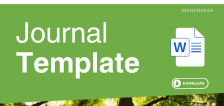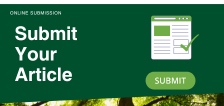KEBERADAAN AMFIBI ORDO ANURA DI BLOK GUNUNG PUTRI TAMAN NASIONAL GUNUNG CIREMAI
Abstract
The research seeks to determine the habitat conditions, characteristics, and diversity of amphibians of the order Anura. The method used in this research is a combination of Line Transect and Visual Encounter Survey (VES). Based on observations using a combination of the Line Transect method and the Visual Encounter Survey method, the number of amphibians species found was 8 species from 5 families including 1 type of family Bufonidae, 2 types of family Dicroglossidae, 1 type of family Megophrydae, 2 types of family Ranidae, and 2 species of family Rhacophoridae. The index of amphibian species diversity in the mount Putri river flow of Mount Ciremai National Park (H') which was obtained at the research location of the Mount Putri Ciinjuk river flow was 1.60. The value of the Eveness index of amphibians that obtained in the Mount Putri river flow was E = 0.77 and The value of the wealth index obtained is R = 1.48 then the temperature and humidity ranges from 19.3 – 20.0°C and 90.5% – 98.4%, with water pH value 6 – 7. The flow of the Mount Putri Ciinjuk river is a balanced habitat for amphibian life where the flow is formed from two steep Mount Ciremai slopes with moist litter conditions and dense canopy cover.
Penelitian ini bertujuan untuk mengetahui kondisi habitat, karakteristik, dan keanekaragaman amfibi ordo Anura. Metode yang digunakan dalam penelitian ini adalah kombinasi Line Transect dan Visual Encounter Survey (VES). Berdasarkan pengamatan menggunakan kombinasi metode Line Transect dan metode Visual Encounter Survey, jumlah jenis amfibi yang ditemukan adalah 8 jenis dari 5 famili diantaranya 1 jenis famili Bufonidae, 2 jenis famili Dicroglossidae, 1 jenis famili Megophrydae, 2 jenis famili Ranidae, dan 2 jenis famili Rhacophoridae. Indeks keanekaragaman jenis amfibi di aliran sungai Gunung Putri Taman Nasional Gunung Ciremai (H') yang diperoleh di lokasi penelitian aliran sungai Gunung Putri Ciinjuk adalah sebesar 1,60. Nilai indeks kemerataan amfibi yang diperoleh di aliran sungai Gunung Putri adalah E = 0,77 dan Nilai indeks kekayaan yang diperoleh adalah R = 1,48 kemudian suhu dan kelembaban berkisar antara 19,3 – 20,0°C dan 90,5% – 98,4% , dengan nilai pH air 6 – 7. Aliran sungai Gunung Putri Ciinjuk merupakan habitat yang seimbang bagi kehidupan amfibi dimana aliran tersebut terbentuk dari dua lereng Gunung Ciremai yang terjal dengan kondisi serasah yang lembab dan tutupan tajuk yang rapat.
Full Text:
PDFReferences
A Alikodra, H.S., 2002 Pengelolaan Satwa Liar Jilid I. Bogor, Indonesia : IPB Press
Aulia, M., Garcia M. J., Schmidt R. B., Schmeller S. Dirk., et al. 2016. The Global Amphibian Trade Flows Throgh Europe : The Need for Enforcing and Improving Legislation. Biodiversity and Conservation. DOI : 10.1007/s1053-016-1193-8.
Bayu, W. Broto. 2012. Keanekaragaman Jenis Herpetofauna di Seksi Pengelolaan Taman Nasional (SPTN) I, Alas Purwo, Banyuwangi, Jawa Timur. 519 – 526.
Brattstrom, B.H. 1963. A Preliminary review of thermal requirements of amphibians. Ecology, 44, 238-255. DOI : 10.2307/1932171
Burne, M.R., & Griffin, C.R. (2005). Habitat associations of pool-breeding amphibians in Eastern Massachusetts, USA. Wetlands Ecology and Management, 13, 247-259. DOI : 10.1007/s11273-004-7519-4.
Churchill, T.A., & Storey, K.B. (2009). Dehydration tolerance in wood frog: a new perspective on development of amphibian freeze tolerance. Am. J. Physiol. Regulatory Integrative Comp. Physiol., 265, 1324-1332. DOI : 10.1152/ajpr egu.1993.265.6.R1324.
riza, Yudi S., Dewi B.S dan Derwmawan A. 2014. Keanekaragaman Jenis Amfibi (Ordo Anura) Pada Beberapa Tipe Habitat di Youth Camp Desa Hurun Kecamatan Padang Cermin Kabupaten Pesawaran. Jurnal Sylva Lestarai. ISSN 2339 – 0913.
Findua, A. W., Harianto, S. P., dan Nurcahyani, N. 2016. Keanekaragaman Reptil Di Repong Damar Pekon Pahmungan Pesisir Barat (Studi Kasus Plot Permanen Universitas Lampung). Jurnal Sylva Lestari. Vol 4. No 1:51-60
Iskandar, D. T. (1998). Amfibi Jawa dan Bali. Seri panduan Lapangan. Cetakan Pertama.Bogor: Puslitbang Biologi-LIPI.
Kapwari, Alhadi, Hamidy, Nopandry, Kirschey, Permana. 2020. Panduan Lapangan Amfibi di Taman Nasional Batang Gadis Sumatra Utara, Medan, Indonesia : Perkumpulan Amfibi Reptil Sumatra (ARS).
Kusrini, M.D. 2008, Pedoman Penelitian dan Survei Amfibi di Alam, Bogor, Indonesia : Fakultas Kehutanan IPB.
Kusrini, M.D. 2019. Metode Survei dan Penelitian Herpetofauna. Bogor, Indonesia : IPB Press.
Mistar. 2003. Panduan Lapangan Anfibi Kawasan Ekosistem Leuser, Bogor: The Gibbon Foundation & PILI-NGO Movement.
Ramazas. 2012. Ekologi Umum. Edisi Kedua.UGM: Yogyakarta.
Robert, F. Inger, & Robert B. Stuebing. 2005. A Field Guide To The Frogs Of Borneo. Kinabalu Sabah Malaysia : Natural History Publications (Borneo) Sdn. Bhd.
Rowe, C.L., & Dunson, W.A. 1995. Impacts of hydroperiod on growth & survival of larval amphibians in temporary ponds of central Pennsylvania, USA. Oecologia, 102, 397–403. DOI : 10.1007/BF00341351
Sanhayani, Reza, Supartono, Toto, Hendrayana, Yayan. 2019. Keanekaragaman Jenis Ordo Anura di Blok Palutungan Seksi Pengelolaan Taman Nasional Wilayah I Kuningan Taman Nasional Gunung Ciremai. 19-20 November 2019. Purwokerto, Jawa Tengah, Indonesia : Lembaga Penelitian dan Pengabdian kepada Masyarakat Universitas Jendral Soedirman.
Stebbins, R.C. & Cohen N.W. 1997. A Natural History of Amphibians. New Jersey, Princeton Univ. Pr.
Wilhm JL, Dorris TC. 1968. Biological parameters for water quality criteria. BioScience. 18:477-81
DOI: https://doi.org/10.25134/wanaraksa.v16i02.9056
Refbacks
- There are currently no refbacks.
Copyright @2013-2024 WANARAKSA nomor ISSN 2776-3986 (Online-Elektronik) dan 0216-0730 (versi cetak).

This work is licensed under a Creative Commons Attribution-NonCommercial-ShareAlike 4.0 International License.
____________________________________________________________________________________________________________________________________________________
WANARAKSA Editorial Office:
Fakultas Kehutanan dan Lingkungan Universitas Kuningan
Jl. Cut Nyak Dhien No.36 A, Cijoho, Kabupaten Kuningan, Jawa Barat 45513, Indonesia
Phone/Whatsapp: +62 81324088139
Website: https://journal.uniku.ac.id/wanaraksa
E-mail: [email protected]






1.png)



_(2)2.png)